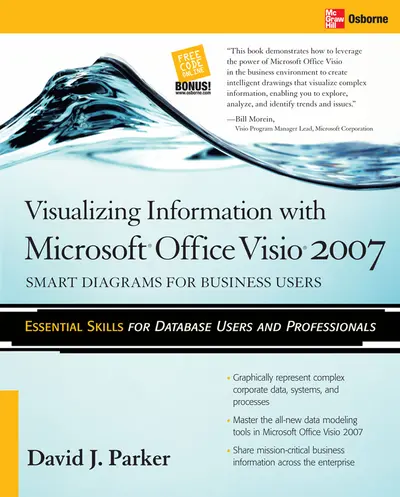My Account Details

ISBN10: 007148261X | ISBN13: 9780071482615

Step 1 . Download Adobe Digital Editions to your PC or Mac desktop/laptop.
Step 2. Register and authorize your Adobe ID (optional). To access your eBook on multiple devices, first create an Adobe ID at account.adobe.com. Then, open Adobe Digital Editions, go to the Help menu, and select "Authorize Computer" to link your Adobe ID.
Step 3. Open Your eBook. Use Adobe Digital Editions to open the file. If the eBook doesn’t open, contact customer service for assistance.
Publisher's Note: Products purchased from Third Party sellers are not guaranteed by the publisher for quality, authenticity, or access to any online entitlements included with the product.
Create and distribute data-connected Microsoft Office Visio diagrams and reports
Get full details on the powerful features of Microsoft Office Visio 2007 inside this comprehensive volume. Written by Visio expert David Parker, Visualizing Information with Microsoft Office Visio 2007 demonstrates how to effectively visualize, explore, and communicate complex business information. Learn to use PivotDiagrams, Data Graphics, and Smart Tags, as well as link data to shapes and create meaningful Visio documents and reports. Plus, you'll get vital security information, time-saving tips, troubleshooting techniques, and downloadable macros and code samples.
Essential Skills for Database Users and Professionals
- Create shapes and link them to data
- Summarize and analyze information using PivotDiagrams
- Use Data Graphics, Smart Tags, and SmartShapes to reinforce information
- Generate robust Excel, HTML, and XML reports
- Create custom, reusable templates, stencils, and masters
- Update and enhance diagrams with Reviewer's comments and markups
- Integrate Visio diagrams with other Windows applications
- Publish and securely distribute Visio documents and summaries
- Extend functionality using VBA macros, add-ins, and wrapper applications
Chapter 2. Shape Data and User-Defined Cells
Chapter 3. Data Linking to Shapes
Chapter 4. Connecting Items to Each Other
Chapter 5. Summarizing Information with PivotDiagrams
Chapter 6. Database Wizard
Chapter 7. Using Data Graphics to Reinforce Information
Chapter 8. Using Smart Tags and Actions
Chapter 9. Creating Reports
Chapter 10. Themes, Backgrounds, Borders, and Titles
Chapter 11. Creating Custom Templates, Stencils, and Masters
Chapter 12. Reviewer's Comments
Chapter 13. Preparing for Publication
Chapter 14. Using Code to Enhance Functionality
Chapter 15. Document Management and Security
Chapter 16. Scenarios
Chapter 17: Epilogue
Index
Need support? We're here to help - Get real-world support and resources every step of the way.
